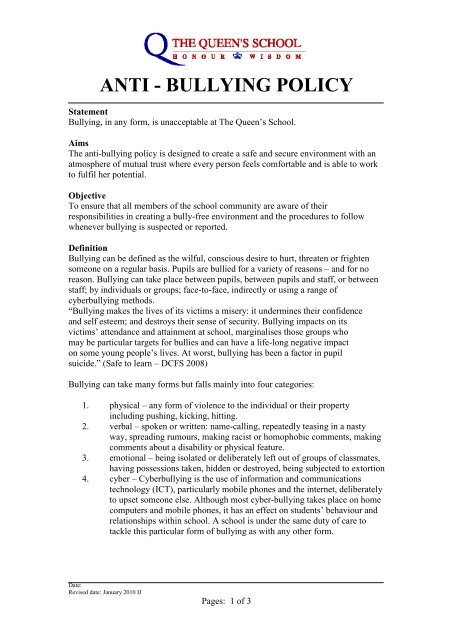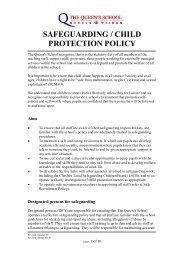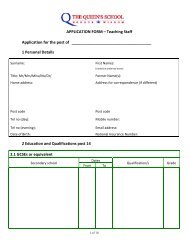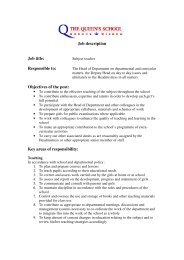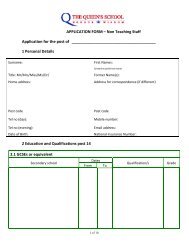ANTI - BULLYING POLICY - The Queen's School
ANTI - BULLYING POLICY - The Queen's School
ANTI - BULLYING POLICY - The Queen's School
Create successful ePaper yourself
Turn your PDF publications into a flip-book with our unique Google optimized e-Paper software.
<strong>ANTI</strong> - <strong>BULLYING</strong> <strong>POLICY</strong>StatementBullying, in any form, is unacceptable at <strong>The</strong> Queen‟s <strong>School</strong>.Aims<strong>The</strong> anti-bullying policy is designed to create a safe and secure environment with anatmosphere of mutual trust where every person feels comfortable and is able to workto fulfil her potential.ObjectiveTo ensure that all members of the school community are aware of theirresponsibilities in creating a bully-free environment and the procedures to followwhenever bullying is suspected or reported.DefinitionBullying can be defined as the wilful, conscious desire to hurt, threaten or frightensomeone on a regular basis. Pupils are bullied for a variety of reasons – and for noreason. Bullying can take place between pupils, between pupils and staff, or betweenstaff; by individuals or groups; face-to-face, indirectly or using a range ofcyberbullying methods.“Bullying makes the lives of its victims a misery: it undermines their confidenceand self esteem; and destroys their sense of security. Bullying impacts on itsvictims‟ attendance and attainment at school, marginalises those groups whomay be particular targets for bullies and can have a life-long negative impacton some young people‟s lives. At worst, bullying has been a factor in pupilsuicide.” (Safe to learn – DCFS 2008)Bullying can take many forms but falls mainly into four categories:1. physical – any form of violence to the individual or their propertyincluding pushing, kicking, hitting.2. verbal – spoken or written: name-calling, repeatedly teasing in a nastyway, spreading rumours, making racist or homophobic comments, makingcomments about a disability or physical feature.3. emotional – being isolated or deliberately left out of groups of classmates,having possessions taken, hidden or destroyed, being subjected to extortion4. cyber – Cyberbullying is the use of information and communicationstechnology (ICT), particularly mobile phones and the internet, deliberatelyto upset someone else. Although most cyber-bullying takes place on homecomputers and mobile phones, it has an effect on students‟ behaviour andrelationships within school. A school is under the same duty of care totackle this particular form of bullying as with any other form.Date:Revised date: January 2010 IJPages: 1 of 3
<strong>ANTI</strong> - <strong>BULLYING</strong> <strong>POLICY</strong>Ongoing prevention of bullying We believe that every girl has the right to enjoy a happy and fulfilling life andto benefit from the opportunities offered at <strong>The</strong> <strong>Queen's</strong> <strong>School</strong>. <strong>The</strong> aim ofour code of conduct is to foster a caring, supportive and purposefulatmosphere within the school to ensure that this right is enjoyed by all. Ourcode is primarily based upon courtesy and respect for each other. (<strong>The</strong>Queen‟s <strong>School</strong> code of conduct) <strong>The</strong> school aims to maintain a safe and caring environment where girls cantalk to someone they trust, be listened to and be given appropriate support inany sensitive situation. (<strong>The</strong> Queen‟s <strong>School</strong> child protection policy) <strong>The</strong> PSE scheme of work addresses all aspects of bullying and related issuesof assertiveness and self-esteem. Positive self-image and appropriate behaviour are promoted throughcurriculum work and assessment. Pupils are encouraged to take an active stand against bullying by not allowingsomeone to be deliberately left out of a group, not smiling or laughing whensomeone is being bullied, telling the bullying pupil to stop, showing thebullying pupil they disapprove of her actions and reporting any incidences ofbullying to a member of staff.A procedure for pupils and staff. Never suffer in silence. Report all incidences of bullying immediately.This can be done either by approaching any member of staff that you find easyto talk to, or in years 7-9 using the „drop a note‟ system in the heads of yearroom, in years 9-11 using the „drop a note‟ system in the library. At <strong>The</strong>Lower <strong>School</strong> girls can leave a note in the pink help box. <strong>The</strong> member of staff will speak to your form tutor, head of year or anothersenior member of staff at the earliest opportunity. <strong>The</strong> member of staff dealing with the matter will investigate the incident andimplement appropriate action. A written record of the incident and the action taken will be kept. Subject teachers may be informed of the situation. <strong>The</strong> member of staff dealing with the incident will monitor and review thesituation to ensure an improvement in your circumstances. <strong>The</strong> school will keep a record of any incidence of bullying, A single incident may be dealt with by your form teacher.A serious or repeated incident will involve your head of year, the head ofschool, the Deputy Head or the Headmistress who may take action in line withthe <strong>School</strong>‟s behaviour policy. Parents of both parties will be involved in serious or repeated incidents. Pupils who are consistently the victims of bullying will be given support todevelop positive strategies and self-assertion; pupils found guilty of bullyingwill be given support to change their behaviour. In serious cases suspension or expulsion of the bully will be considered.Date:Revised date: January 2010 IJPages: 2 of 3
<strong>ANTI</strong> - <strong>BULLYING</strong> <strong>POLICY</strong>Childline runs an excellent supportline on 0800 11 11If you are the victim of cyber-bullying: tell a teacher or parent about the bullying do not reply to bullying messages do not retaliate by sending unpleasant messages back switch off your phone – it‟s the most effective way to block the texting bully use the blocking and reporting facilities of social networking sites if necessary, change your contact details such as your instant messagingidentity or your mobile phone number save the evidence. Keep printed copies, records and dates of offensivemessages, pictures and online conversations. Refer to the „BBB locked‟section of www.websafecrackerz.com to learn how to do this.www.cybermentors.org.uk offer excellent online support for young people who arethe victims of cyberbullying.A procedure for parentsIf you are concerned about your child being bullied the facts of the situation are vitalas, without these, it is hard to take action.1. calmly talk to your daughter about the experience;2. make a note of what is said, particularly names, places, times, how oftenand the form the bullying takes.3. reassure your daughter that she has done the right thing. She should notfeel guilty.4. explain to your daughter that any further incidents should be reportedimmediately to a member of staff;5. do not hesitate to contact the school so that bullying can be dealt withappropriately.6. read the notes on cyber-bullying above. Evidence will be needed by theschool for intervention to be effective and this evidence may also beneeded by internet service providers and mobile phone companies. If thecyber-bullying breaks the law, the evidence may be needed by the policefor an investigation. Please note that internet service providers will onlyremove text or photos if they break the law or the company‟s own termsand conditions.Bullying of staffAny incident of bullying where a member of staff is the victim should be reportedimmediately to a member of the SMT. If the Headmistress is the alleged bully theincident should be reported in writing to the Chair of Governors. You may also wishto refer to your union for advice.Date:Revised date: January 2010 IJPages: 3 of 3


